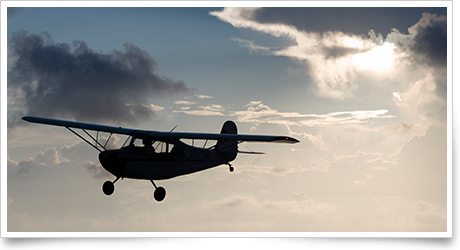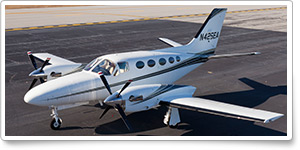June 14, 2013, issue of 'AOPA ePilot: Flight Training Edition' weekly newsletter
|
||||||
|
Fast and furious |
|
|||||
Training TipsFast and furious
That speed of growth is important because it helps you set a freshness date on your weather briefing and periodic updates. Since it doesn't take long for convective conditions to develop, any conditions conducive to convection in your flight’s weather profile deserve constant monitoring.
Even if thunderstorms are not specifically mentioned in your briefing, indicators—high dew points, an unstable atmosphere, an approaching front—should put you on alert. If you will depart in a hazy, stable air mass with reduced visibility and fly toward an advancing front, be wary of embedded weather hazards.
Just before heading out, give weather radar a final glance on a computer terminal; animating the display will show you the speed, direction and intensity of areas of precip. Not available? Then make sure you can read and decode a radar weather report (RAREP). There is an example on page 12-10 of the Pilot’s Handbook of Aeronautical Knowledge.
Once airborne, remember that a squall line can develop ahead of an advancing front—also with little warning. Note the navaids that transmit hazardous in-flight weather advisory service broadcasts; a HIWAS broadcast may be your first clue that conditions are changing for the worse.
One of the many benefits of receiving flight following services from ATC is hearing any announcement that a convective sigmet has been issued. Follow up with HIWAS, or give flight watch a call.
Perilous is any decision to land in haste at an airport in the path of an approaching storm. If you win the race to the airport, a gust front—or worse, a microburst—could still beat you to the punch.
“The wind’s downward movement is part of the danger when an aircraft flies into a microburst. But, the biggest danger is a sudden shift in wind direction,” wrote meteorologist Jack Williams in this installment of “The Weather Never Sleeps” in Flight Training magazine.
In any scenario involving thunderstorms, safety requires putting as much distance as possible between you and the rough stuff. Some pilots try to shave that margin. That’s a losing bet. Flight Training NewsAOPA seeks young pilot to send to FranceIt could be the perfect two-week getaway: a free trip to France to participate in the Tour Aérien Des Jeunes Pilotes. The goal of the Tour Aérien Des Jeunes Pilotes is to motivate the next generation of pilots, build camaraderie, and serve as a public outreach event promoting general aviation. Forty-five pilots between the ages of 18 and 24 are expected to participate in the event July 15 through 28. Each stop in the race will allow participants to meet with the public and share their passion for aviation. Read more >> Technique: Nose up, unload, roll!A roll is a great confidence boost for new aerobatic pilots, and getting the airplane upside down and right side up again requires decisive control inputs. A roll is the first aerobatic maneuver an aerobatic student learns, and it should be a confidence booster as well as a clean break from the past. It boosts confidence because rolling shows students they are capable of getting the airplane upside down and right side up again, and it's not disorienting since the horizon is plainly in view throughout the maneuver. Read more >> Weigh these weight-and-balance apps for yourselfAOPA eNewsletter and Social Media Editor Benét J. Wilson’s last column on weight-and-balance apps turned out to be one of the most popular with members. She received more than a dozen recommendations from members. So this week, she takes a look at another five. Read more >> Brazilian student team wins aircraft design competitionPrice Induction has named a team from Federal University of Minas Gerais in Brazil as the winner of a student competition that asked aerospace engineering students to imagine and design the best personal light jet based on a four-seat twin-engine aircraft equipped with Price Induction DGEN 390 turbofan engines. Students were given special access to technical data and software. The Brazilian team presented a configuration similar to a glider with the two engines mounted on the fuselage. Air Facts sponsors summer writing challenge for young pilotsAir Facts is seeking contributions from young pilots about their flying experience for its online journal for personal air travel as part of its summer writing challenge. Pilots from 16 to 24 years of age should submit a 750- to 1,000-word personal essay on one of the following subjects: the moment I felt like a pilot, my first passenger, “I messed up,” five flying adventures I want to have, or topic of your own choosing. Applicants should submit their essay in a Word document, along with a digital photo of themselves and a 50-word biography. Submissions should be sent to [email protected]. Thunderstorm Avoidance: Practical tips for the GA pilotThunderstorms present a multitude of weather conditions that are disastrous to aircraft such as hail, icing, lightning, extreme turbulence, wind shear, and heavy winds. There's no denying the danger these storms pose to flyers, yet far too many pilots venture into these convective beasts and never make it out alive. Test your knowledge by taking the Air Safety Institute's thunderstorm avoidance quiz and learn why smart pilots never take a chance. Take the quiz >> Training ResourcesThe ups and downs of takeoffs and landingsThe “simple” act of taking off or landing accounts for 50 percent of general aviation accidents. It affects students, flight instructors, and veterans alike. The leading accident factor for both phases is loss of control (30.2 percent of takeoff accidents and 32.8 percent of landing accidents). Other factors include obstructions, night operations, short fields, and soft fields. Check out this Air Safety Institute safety advisor that offers tips on having successful takeoffs and landings. Read more >>
Did you know that student pilots who join AOPA are three times more likely to complete their flight training? Membership includes unlimited access to aviation information by phone (800/USA-AOPA, weekdays from 8:30 a.m. to 8 p.m. Eastern time) or from Flight Training Online or AOPA Online. If you’re not already a member, join today and get the pilot’s edge. Login information is available online.
Inside scoop on FAA demands for AirVenture user feesThe FAA takes a big step toward replacing 100LL. Get the inside story on the FAA’s user fee demands to EAA AirVenture in Oshkosh, Wis. Take a look at new aerobatic airplanes from American Champion and Waco Classic. Learn about dealing with depression—it happens to pilots, too. And see the faces behind those “Pull up!” and “Terrain!” warnings in your cockpit. AOPA Live This Week, June 13 >> Career PilotFirst Boeing 787-9 Dreamliner begins final assemblyBoeing began final assembly of the first 787-9 Dreamliner on schedule May 30 in Everett, Wash., when it started joining large sections of the efficient new jet. Partners delivered the first 787-9 sections to final assembly on or ahead of schedule, said Boeing, which will build the first three 787-9s on its temporary surge line in Everett to allow for smoother integration of the variant into production while continuing to ramp up 787 manufacturing. The 787-9 is 20 feet longer and will carry 40 more passengers an additional 300 nautical miles. First flight of the 787-9 is scheduled later this year, with first delivery to launch customer Air New Zealand set for early 2014. Twenty customers have ordered 355 787-9s, accounting for 40 percent of all 787 orders. American mechanics seek Teamsters representationAmerican Airlines mechanics and related workers filed for an election with the National Mediation Board on May 28 as part of a months-long effort to become Teamsters. The petition comes on the heels of a similar move by US Airways mechanics, also seeking Teamster representation, who filed May 7 for an election. American Airline's more than 11,000 mechanics and related workers launched a campaign last June to obtain representation by the Teamsters Airline Division and the Teamsters Aviation Mechanics Coalition.
For more aviation career news, see the Flight Training website. Plane SpotterA history of Conquest
Training ProductsKing Schools offers sport pilot test prepThe King Schools Sport Pilot Practical Test Course on CD shows students exactly what the FAA wants you to demonstrate to earn your rating. The course shows you a real-world practical test, including both the oral and flight portions. The course costs $119. FAA offers GA pilot weather guideThe FAA offers the General Aviation Pilot’s Guide to Preflight Weather Planning, Weather Self-Briefings, and Weather Decision Making. The guide is intended to help GA pilots, especially those with relatively little weather-flying experience, develop skills in obtaining appropriate weather information, interpreting the data in the context of a specific flight, and applying the information and analysis to make safe weather flying decisions.
Note: Products listed have not been evaluated by ePilot editors unless otherwise noted. AOPA assumes no responsibility for products or services listed or for claims or actions by manufacturers or vendors. Member BenefitsLegal 101: For studentsAs students embark on the journey of learning how to fly, they quickly learn that it involves more than knowing how to manipulate the controls to make the aircraft fly and navigate the sky. Sooner or later, students come to understand that there are a myriad of rules and regulations that must be learned and memorized. From experience, AOPA Counsel Kathy Yodice can tell you that those rules and regulations can be very complicated and some are subject to interpretation and robust debate. Read more >> BlogsJust ahead in the July issueWhat great summer trips are you planning this year? What hot-weather issues confound you as you progress through your flight training? The July 2013 issue of Flight Training magazine, just off to the printer, touches on weight and balance, density altitude, and nailing your best glide speed in the event of an engine failure. Read more >> The coolest airplane I’ve ever seenFK Lightplanes, one of the top small-aircraft manufacturers in Europe, has designed a FK51 70-percent replica of the famous P-51 Mustang using whimsy, a passion for flying, and a sense of humor. It weighs only 1,000 pounds (a limit for ultralights in Europe), has retractable landing gear (can’t do that in the American light sport aircraft world), and three very special details. You can see a video about it with designer Peter Funk of South Africa on bydanjohnson.com. Read more >> AOPA Career OpportunitiesEver dream of turning your passion for aviation into a career? We’re looking for a director of corporate partnerships, marketing specialist, member services representative, human resources assistant, software test and quality assurance analyst, and AOPA Live editor/graphic artist. To learn more about other AOPA career opportunities, visit AOPA Online. Community
AVIATION EVENTS & WEATHER
|
||||||||||||||||||||||||||||||||||||









